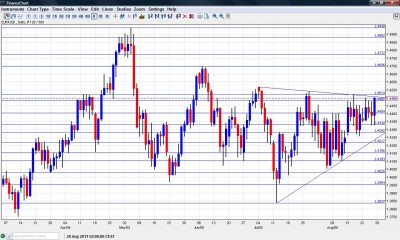Euro/dollar eventually closed higher after conquering fears. Is it about to break higher? The upcoming week is very busy, and consists of important figures for the next rate decision. Here is an outlook for these events, and an updated technical analysis for EUR/USD.
It seems that QE3 is off the table in the US. Or is it really so? In Europe, more signs of slowdown are evident, with two surveys pointing lower. Is Trichet ready to lower the rates? In his speech in Jackson Hole, he left no clues.
EUR/USD daily chart with support and resistance lines marked. Click to enlarge:
- German CPI: Monday. The German states release their initial CPI estimates throughout the day. After a relatively strong rise of 0.4% last month, the slowdown and the fall in commodity prices is now expected to be reflected in no change in prices.
- German Retail Sales: Wednesday, 6:00. Europe’s largest economy enjoyed a big leap sales volume last month – 4.5%. A big fall is expected now – 1.5% – a fall that will correct the previous leap.
- German Unemployment Change: Wednesday, 7:55. The slowdown in German growth is also felt in the job market. The drops in unemployment fell in the past months. A drop of 10K is predicted now, similar to last month’s -11K.
- CPI Flash Estimate: Wednesday, 9:00. The all European rate of inflation surprised with a drop to 2.5% last month – also reflecting the slowdown. The same pace is expected to be kept now. A drop towards the official target of 2% will weaken the euro. We’ve already seen core inflation drop.
- Unemployment Rate: Wednesday, 9:00. The euro-zone’s unemployment rate stood on 9.9% for quite a long time – 5 months. No change is likely now. There is a big difference between countries like Germany which have a single digit unemployment rate, and countries like Spain with above 20%.
- German Final GDP: Thursday, 6:00. Germany’s growth significantly slowed down in Q2 according to the first release – only 0.1%. This will probably be confirmed now. Revisions are not common.
- Final Manufacturing PMI: Thursday, 8:00. According to the first release, the euro-zone’s manufacturing sector dipped into contraction zone. The score of 49.7 points, under 50, means that the sector is squeezing. This will likely be confirmed now.
- PPI: Friday, 9:00. Germany surprised with a big and unexpected jump in import prices. This will probably be seen in producers prices for the whole zone – a rise of 0.6% is estimated now.
* All times are GMT.
EUR/USD Technical Analysis
Euro/dollar traded in range throughout most of the week. The 1.4450 line served (mentioned last week) served as a weak cap. In the final hours, the pair managed to break higher, just under 1.45.
Technical levels, from top to bottom
In case that the euro runs higher, 1.4940 is the highest level this year, and currently the final frontier. Minor resistance is at 1.4882, a peak that later worked as support.
1.4775 is a significant line in high ground, after being pivotal when the pair traded there. 1.47 follows as a minor line.
1.4650 was a peak in the past and is minor resistance. 1.4520 is the next significant level below. It capped the euro for another week in a row, and also had a similar role in the past.
1.4480 now replaces 1.4450 – it worked better as a cap and now provides immediate, yet weak support. 1.4330 replaces 1.4350. It was a double bottom just now.
The peak of November 2010 at 1.4282 is is still with us as usual. While this line works better as resistance than as support, it was doing a great job in providing support now. 1.4220 was a pivotal line in the past week, the middle of the range between two stronger lines.
1.4160 returned to having an important role in supporting the pair, despite being breached. Moving lower, the round number of 1.41 provides stronger support now, after preventing a collapse.
Just above the round number of 1.40, we find very important support at 1.4030 – it was successfully tested earlier in the summer. Lower, 1.3950 was a pivotal line when the pair traded in lower ranges and proved that it is of high importance. After the comeback, this line was another clear support line.
The bottom of 1.3838 will be closely watched in another fall. This was also a line of support last year. Below, 1.3750 is significant support, if the pair falls to a five month low.
Narrowing channel
The narrowing channel seen in the chart is even more relevant now. Downtrend resistance begins at the end end of June and is quite moderate. Uptrend support begins from the swing low in July and is more sharp. We are close to downtrend resistance now.
I remain bearish on EUR/USD.
The interpretation of a possibility of QE3 gave a boost to the euro, but the situation in euroland is far from optimal. The core is weakening, and the peripheral countries are still struggling. So is the banking system.
FX Tech Strategy sees hesitation in the pair (technical analysis).
If you are interested in an alternative way of trading, check out the weekly binary options setups, including EUR/USD of course.
Further reading:
- For a broad view of all the week’s major events worldwide, read the USD outlook.
- For the Japanese yen, read the USD/JPY forecast.
- For GBP/USD (cable), look into the British Pound forecast.
- For the Australian dollar (Aussie), check out the AUD to USD forecast.
- For the New Zealand dollar (kiwi), read the NZD forecast.
- For the Swiss Franc, see the USD/CHF forecast.
- USD/CAD (loonie), check out the Canadian dollar.

